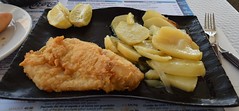Nerja
Nerja is a tourism-oriented town on the Costa del Sol in the province of M├â┬â├é┬ílaga, which lies in one of Spain's 17 autonomous regions, Andaluc├â┬â├é┬şa, on the country's southern, Mediterranean coast. It lies about 50 km east of the city of M├â┬â├é┬ílaga, and is within 1 hour 15 minutes drive of the Alhambra in the city of Granada, and 30 minutes more to skiing in the Sierra Nevada Mountains.
History
Nerja has a long history, evidenced by the primitive paintings found in its famous Nerja caves, discovered in 1959, and now Spain's third most-visited tourist attraction (after the Prado in Madrid and the Alhambra Palace. These caves are now believed to be just one entrance to a linked series of potholes stretching many miles into the mountains between Nerja and Granada, and which may yet prove to be one of the most extensive unexplored systems in Europe.The Romans gave the settlement the name "Detunda", and it was later taken over by the Arabs. Under the Muslims, it became "Narixa", which means "abundant spring", and is the origin of its present name.Its agricultural and silk products are said to have been famed throughout the Muslim world and in the markets of Damascus as early as the tenth century.The
Balcón de Europa, a
mirador or viewpoint which gives stunning views across the sea, is in the centre of the old town. Its name is popularly believed to have been coined by King Alfonso XII, who visited the area in 1885 following a disastrous earthquake and was captivated by the scene. However, local archive documents are said to show that its name predated this visit.The Balcón area was originally known as La Bateria, a reference to the gun battery which existed there in a fortified tower. This emplacement and a similar tower nearby were destroyed by British led forces under Major General Blayney in 1810 to deny their use to French occupying forces during the Peninsular War.
Modern Nerja
In more modern times, sugar cane production has given way to more valuable cash crops, particularly semi-tropical fruits such as mango and papaya and widespread avocado plantations in what is one of the major avocado growing regions in Europe.It is the eastern-most town in the area known as the Axarqu├â┬â├é┬şa and has an official population of around 20,000 ├â┬ó├ó┬é┬Č├ó┬Ç┬Ł a fifth of which are foreign residents, including around 2,000 British ├â┬ó├ó┬é┬Č├ó┬Ç┬Ł although the true expatriate population is probably twice that. In the summer months, tourism swells the population several times more.Nerja has several fine beaches set in charming coves beneath cliffs and one of the best climates in Europe. It is also becoming a significant centre for walkers, thanks to the dramatic mountain scenery of the nearby Sierra de Almijara and Sierra Tejeda.
Twin towns
Literary Nerja
Nerja long been a source of inspiration for expatriate writers and artists.
Nerja in popular fiction
Fictional books that are set wholly of partly in Nerja include:
- Balcony of Europe, a 'novel' by the Irish writer Aidan Higgins, who based it on his Bohemian life in the village in the early 1960s.
- Leisure, early 21st century pulp fiction about sunseeking holidaymakers, by English author Kevin Sampson.
- Encarnita's Journey, by Joan Lingard. The novel features a Spanish woman living in Nerja in the last decades of the 20th century, whose life story spans 8 decades in places which also include the Alpujarras in the time of the writer Gerald Brenan, and Almu├â┬â├é┬▒├â┬â├é┬ęcar during the time of the Spanish Civil War.
Nerja in non-fiction works
Books describing the experience of British immigrants to the Axarquia include:
- Life in the Campo, by Maggie Hutton
- A New Life in Spain, by Toby Wolrych
- Tomorrow is Mañana in an Andalusian Village, by the Australian travel writer Shirley Deane, who lived in Nerja in the mid 1950s.
External links










